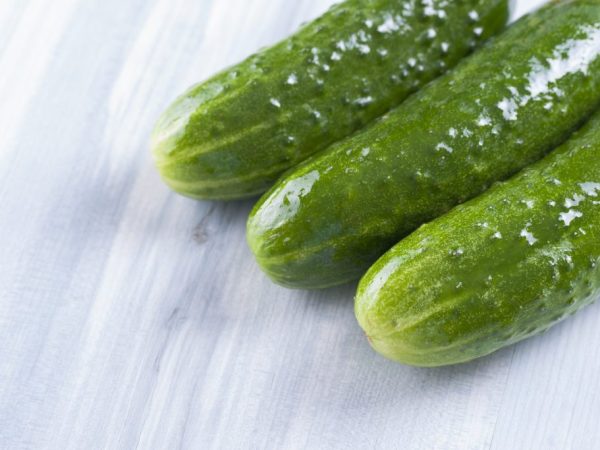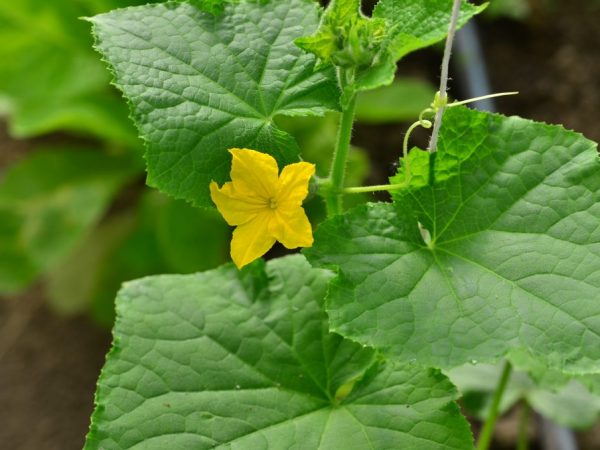Characteristics of the variety of cucumbers Bogatyrskaya power
The choice of varieties of cucumbers for planting depends on the needs of the gardener. Cucumber variety Bogatyrskaya strength takes root well, is unpretentious in care and does not require frequent watering, and therefore will be an excellent choice for planting on the site.

Characteristics of the variety of cucumbers Bogatyrskaya power
Characteristics of the variety
Cucumber f1 Heroic strength belongs to early maturing crops of the parthenocarpic type.
The cucumber variety Bogatyrskaya Sila has a female flowering type and is suitable for growing in greenhouse conditions (spring greenhouses or winter greenhouses) and outdoors. A bunchy gherkin hybrid quickly takes root on new soil, so transplanting seedlings is carried out at the end of April after the last frost.
The f1 hybrid has a good yield: up to 20 kg of tasty and juicy cucumbers are harvested from one bush. The variety has a long growing season: the bush bears fruit until the end of September. Bunch cucumbers need regular processing and frequent harvesting.
A distinctive feature of Bogatyr's strength is the limited growth of lashes that do not take away food from the zelents.
Description of the bush
The bushes of the variety have good lateral shoot growth: there are 2 types of self-regulating branching. Thanks to this, the fruiting period of the bush is extended. A high parthenocarp of the plant is observed on the main stem during the period of active growth. In the nodes, from 2 to 8 ovaries are formed.
The main characteristics of the bush:
- overgrowing thick lashes entwine the main stem;
- massive leaves of dark green color;
- powerful root and strong main stem.
For the f1 hybrid, the planting density is 1 plant per 1 sq. m in greenhouse conditions and 3 per 1 sq. m outdoors. Crowding of the planted seedlings leads to deformation of the lashes and damage to the root part.
The green part of the bush can withstand sudden changes in temperature. The root system of the plant is located in the upper layers of the soil and provides the stem with the necessary moisture. The rapid growth of the bush is due to proper watering and care, as well as timely harvesting.
Description of fruits
Due to the abundant flowering, up to 6-8 fruits are formed on one lash.
Description of cucumbers:
- oval oblong fruit shape;
- cucumber length - from 8 to 14 cm;
- fruit diameter - about 3 cm;
- greens with medium pubescence.
The cucumber is juicy, with a dense core, has a small amount of seeds. A cucumber with a thick, dark green skin tolerates long-term transportation well.
The salting qualities of the fruits are high. Gherkins are used raw or to make delicious pickles for the winter. The cucumber can be stored for up to 2 weeks without losing its presentation.
Care and watering

The yield of the plant depends on the quality of care.
The variety needs timely watering, and the bushes need to trim excess lashes.
Fertilizing the plant allows the main stem to form quickly: the first ovaries appear within 2-3 weeks after planting the seedlings.Before the start of active flowering, seedlings in the open field are covered with a film: in such conditions, the seedlings grow faster and do not suffer from changes in external temperature. Tufted cucumbers are planted in the shade, avoiding blown land.
The variety needs constant feeding. The irrigation system involves irrigating the soil and the stem twice a week. During heavy rains, watering is temporarily stopped. Irrigation work alternates with soil fertilization: for these purposes, nitrogen fertilizers and mineral complexes are used, which strengthen the green part of the bush. The amount of fertilizers applied is calculated in the proportion of 15 g of nutrients per 1 sq. m of soil. The soil is fertilized with homemade substances: rotted foliage or manure activates the growth of plant cells.
After the appearance of zelents, the harvest is carried out every 2 days, otherwise the overripe fruits interfere with the appearance of new ovaries. The bush does not require pinching, pruning of the lashes is carried out only when the hybrid is sick or individual lashes are damaged.
Diseases and pests
The developed variety is resistant to most of the diseases that threaten cucumbers or tomatoes.
The olive spot is only threatened by the hybrid when the bushes are weak or depleted: the fungal disease affects the upper part of the bush and spreads to healthy crops. Olive spot reduces the yield of bushes by 2 times and harms the root system of the bunch variety.
The cucumber mosaic virus does not threaten the hybrid, even a weakened plant does not suffer from diseases of this kind.
Downy mildew is rare, but in unfavorable conditions, parasites infect the stem and whips of cucumbers. Downy mildew threatens bushes that are planted in unfertilized depleted soil - before planting seedlings, you should pay attention to the condition of the soil, and, if necessary, apply a large amount of fertilizer.
Aphids and ticks are a threat to cucumbers. Symptoms of damage by these pests are a change in the color of the foliage and stem. To protect the hybrid, use means to strengthen the root system, insecticides.
Conclusion
Parthenocarpic gherkins are a good choice for the gardener. Plants are easy to care for and yield stable yields. The fruits of the hybrid are massive and tasty, suitable for making salads and spinning for the winter.
The hybrid requires regular watering and periodic fertilization of the soil. Weak plants are susceptible to fungal diseases. The bushes are not protected from the invasion of insects and pests.


